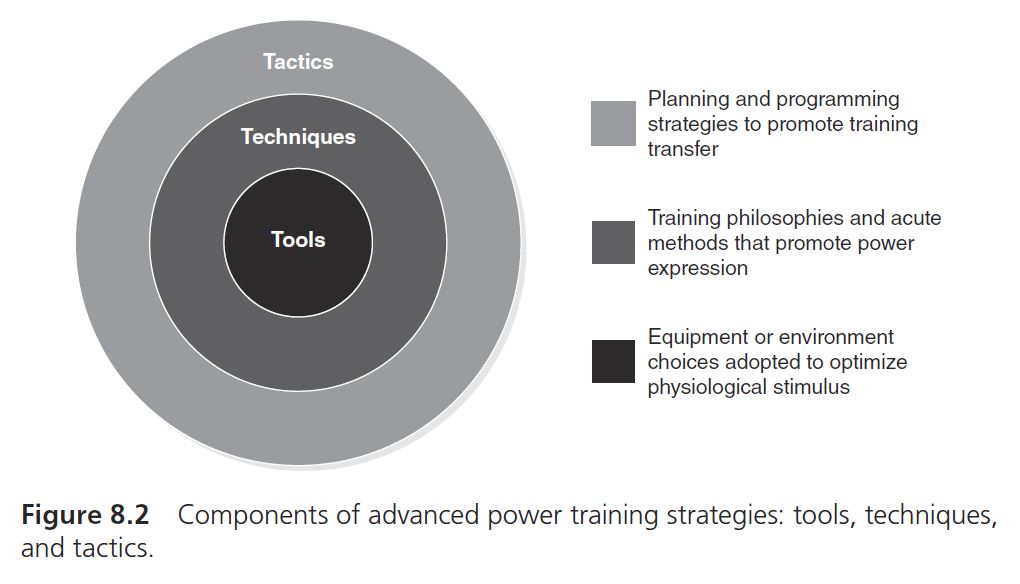Training Philosophy
by Developing Power
Kinetic Select
October 2019
When considering applying advanced methods to affect and augment maximal power output, this excerpt from Developing Power explains three key points to consider.
The following is an exclusive excerpt from the book Developing Power, published by Human Kinetics. All text and images provided by Human Kinetics.
When traditional approaches to maximal strength and rate of force development (RFD) training no longer result in the magnitude of physiological or performance adaptation desired, the practitioner must find alternative approaches to muscular power development. Advanced power training methods represent the stimulus required to introduce training variety that ultimately breaks a training plateau or to promote an ongoing increase in performance enhancement through new morphological and neurological adaptation (18). Within any given training regimen are a multitude of opportunities to modulate the characteristics of the training stress in order for it to be considered advanced in its approach. However, it is critical that more complex training methods are brought into the holistic physical development program at the correct time and with the appropriate progression, and that advanced methods are not simply introduced adjunct to fundamental power training methods (i.e., increasing maximal force and maximal velocity). Instead, advanced power training techniques should be considered novel strategies that complement an athlete’s individual needs as required. When considering applying advanced methods to affect and augment maximal power output, keep the three Ts in mind: the tools used, the techniques adopted, and the tactics applied. Each of these categories can then be manipulated in order to impart a significant stimulus to the overall training stress (Figure 8.2).

Tools
Tools are the equipment or environmental choices an athlete or coach can adopt in an effort to optimize the training stimulus beyond the methods traditionally used in power training. Strength and conditioning professionals often refer to their “tool box” as the equipment they use to make exercises more challenging or complex. They also use this idea to refer to the way in which they modify equipment to better reflect the biomechanical characteristics desired and the environmental constraints that they place on an athlete in order to challenge force–velocity characteristics. For example, within traditional power training, a decision often considered by strength and conditioning coaches is the execution of Olympic weightlifting variants using either a barbell or dumbbells (Chapter 7). Both tools can emphasize the triple extension of the hip, knee, and ankle joints synonymous with peak power outputs (12,65). However, it is highly likely that the choice of tools will significantly affect biomechanical characteristics, motor unit recruitment, and the nature of the force–velocity relationship that is being accentuated (65).
Techniques
Power training techniques are philosophies and methodologies that can be applied within a given training session to promote muscular power. While all approaches to training might be considered techniques in their own right (e.g., free-weight resistance training vs. plyometric training), our understanding of training science has progressed sufficiently over the past 50 years, such that we can now classify training regimens specifically by the techniques they adopt. For example, eccentric strength training is widely recognized as a training strategy in itself, with a growing body of scientific evidence to support the morphological and performance adaptations that this technique offers (36). Elsewhere, the term plyometrics is commonplace. However, within the paradigm of plyometric training, the taxonomy of exercises leads us to further acknowledge the classification of techniques identified as shock method training and those simply termed plyometrics (102). Consequently, specific training techniques should be considered when planning and programming advanced power training methods (see Chapter 3).
Tactics
Finally, the tactics of advanced power training are planning and programming strategies that overarch training methods. They are used within defined phases of training to promote the transfer and realization of power training methods in performance. Programming of advanced training is a central factor in fulfilling the likelihood that a training modality or technique will result in the desired physiological effect. In most instances, the purpose of planning and programming is to manage the fitness–fatigue relationship directly (i.e., overload and recovery) (55,97). Nowhere should this be more apparent than when performing advanced training methods, during which the optimization of the training stimulus must be apparent because of the rationale that traditional planning and programming methods were failing to impart further beneficial effects, and thus, advanced methods are to be introduced.
With Developing Power, the National Strength and Conditioning Association (NSCA) has created the definitive resource for developing athletic power. With exercises and drills, assessments, analysis, and programming, this book will elevate power and performance in all sports. The book is available in bookstores everywhere, as well as online at the NSCA Store.
- Privacy Policy
- Your Privacy Choices
- Terms of Use
- Retraction and Correction Policy
- © 2025 National Strength and Conditioning Association